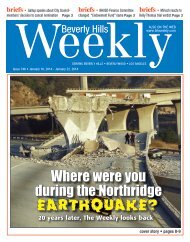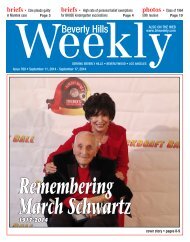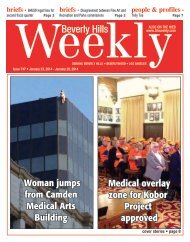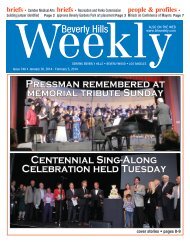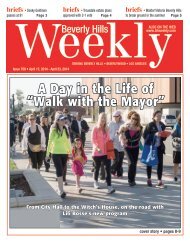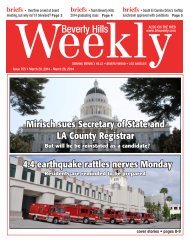1msgpqB
1msgpqB
1msgpqB
Create successful ePaper yourself
Turn your PDF publications into a flip-book with our unique Google optimized e-Paper software.
ABSENT: Councilmember Krasne<br />
CARRIED<br />
ORDINANCE NO. 14-O-2659<br />
AN ORDINANCE OF THE CITY OF<br />
BEVERLY HILLS REGULATING TOBACCO<br />
AND ELECTRONIC CIGARETTE USE IN<br />
OUTDOOR SERVICE LINES, FARMERS<br />
MARKETS, PUBLIC PLAZAS AND<br />
OUTDOOR PUBLIC GATHERING PLACES.<br />
THE CITY COUNCIL OF THE CITY<br />
OF BEVERLY HILLS HEREBY ORDAINS AS<br />
FOLLOWS:<br />
Section 1. On April 1, 2014, the<br />
City Council considered the introduction of this<br />
Ordinance at a duly noticed public meeting and on<br />
the basis of the record thereof finds the following<br />
facts to be true:<br />
A. Tobacco use and exposure to<br />
secondhand smoke cause death and disease and<br />
impose great social and economic costs; and<br />
B. The Centers for Disease<br />
Control and Prevention have found that more than<br />
480,000 people die in the United States from tobacco-related<br />
diseases every year, making it the<br />
nation’s leading cause of preventable death 1 ; and<br />
C. The World Health<br />
Organization estimates that by 2030, tobacco will<br />
account for eight million deaths per year, making it<br />
the greatest cause of death worldwide 2 ; and<br />
D. The U.S. Environmental<br />
Protection Agency has found secondhand smoke<br />
to be a risk to public health and has classified<br />
secondhand smoke as a group A carcinogen, the<br />
most dangerous class of carcinogen 3 ; and<br />
1<br />
Centers for Disease Control and Prevention.<br />
Tobacco-Related Mortality. February 6, 2014.<br />
http://www.cdc.gov/tobacco/data_statistics/fact_<br />
sheets/health_effects/tobacco_related_mortality<br />
2<br />
World Health Organization. Tobacco Fact Sheet<br />
No. 339. July 2013. http://www.who.int/mediacentre/factsheets/fs339/en/<br />
3<br />
U.S. Environmental Protection Agency. Health<br />
Effects of Exposure to Secondhand Smoke. http://<br />
www.epa.gov/smokefree/healtheffects.html<br />
E. Secondhand smoke is responsible<br />
for an estimated 42,000 deaths among<br />
non-smokers each year in the United States,<br />
which includes 7,333 lung cancer deaths and<br />
33,951 deaths due to heart disease 4 ; and<br />
F. Electronic cigarettes, commonly<br />
known as e-cigarettes, e-cigars, e-cigarillos,<br />
e-pipes, and e-hookahs, are battery operated<br />
devices designed to look like and be used in the<br />
same manner as conventional tobacco products.<br />
Electronic cigarettes employ the use of a cartridge,<br />
generally containing up to 20 mg of nicotine<br />
to deliver vaporized nicotine to users. Some<br />
cartridges used by electronic cigarettes can be refilled<br />
with liquid nicotine solution, creating the potential<br />
for exposure to dangerous concentrations<br />
of nicotine 5 ; and<br />
G. The U.S. Food and Drug<br />
Administration (“FDA”) conducted laboratory<br />
analysis of electronic cigarettes and found the following:<br />
1) Diethylene glycol, an ingredient used<br />
in antifreeze and toxic to humans, was found in<br />
one cartridge; 2) Certain tobacco-specific nitrosamines,<br />
which are human carcinogens, were detected<br />
in half of the samples tested; 3) Tobaccospecific<br />
impurities suspected of being harmful to<br />
humans—anabasine, myosmine, and ß-nicotyrine—were<br />
detected in a majority of the samples<br />
tested; 4) All but one tested cartridge labeled as<br />
containing no nicotine did in fact contain low levels<br />
of nicotine; 5) Three identically labeled cartridges<br />
emitted markedly different amounts of nicotine<br />
with each puff. Nicotine levels per 100 mL puff<br />
ranged dramatically from 26.8 to 43.2 mcg nicotine;<br />
and 6) One high-nicotine cartridge delivered<br />
twice as much nicotine to users as was delivered<br />
by a nicotine inhalation product approved by the<br />
FDA for use as a smoking cessation aid which was<br />
used as a control; and<br />
4<br />
U.S. Department of Health and Human Services.<br />
The Health Consequences of Smoking—50 Years<br />
of Progress. A Report of the Surgeon General.<br />
2014. http://www.cdc.gov/tobacco/data_statistics/<br />
sgr/50th-anniversary/index.htm<br />
5<br />
Yamin, C.K., Bitton A., and Bates, D.W.<br />
E-Cigarettes: A Rapidly Growing Internet<br />
Phenomenon. Annals of Internal Medicine,<br />
153:607-609, 2010.<br />
H. The FDA has raised concerns<br />
that electronic cigarettes, which are often<br />
marketed in appealing flavors, can increase nicotine<br />
addiction among young people and may lead<br />
youth to try conventional tobacco products 6 ; and<br />
I. The FDA has also raised concerns<br />
that electronic cigarettes are marketed and<br />
sold to young people and are readily accessible<br />
online and via mall kiosks 7 ; and<br />
J. A study published in the<br />
American Journal of Public Health found similar<br />
results to the FDA testing and concluded that the<br />
electronic cigarettes tested so far have demonstrated<br />
“poor quality control; toxic contaminants,<br />
albeit at low levels; misrepresentation of the nicotine<br />
delivered; and insufficient evidence of the<br />
overall public health benefit” 8 ; and<br />
K. Clinical studies about the<br />
safety and efficacy of electronic cigarettes for their<br />
intended use have not been submitted to the FDA,<br />
and for this reason, consumers currently have no<br />
way of knowing: 1) whether electronic cigarettes<br />
are safe for their intended use; 2) what types or<br />
concentrations of potentially harmful chemicals<br />
the products contain; and 3) what dose of nicotine<br />
the products deliver 9 ; and<br />
L. The World Medical<br />
Association has determined that electronic cigarettes<br />
“are not comparable to scientifically-proven<br />
methods of smoking cessation” and that “neither<br />
their value as therapeutic aids for smoking cessation<br />
nor their safety as cigarette replacements is<br />
established” 10 ; and<br />
6<br />
U.S. Food and Drug Administration. E-Cigarette:<br />
Questions and Answers. 2010. www.fda.gov/forconsumers/consumerupdates/ucm225210.htm<br />
7<br />
U.S. Food and Drug Administration. News<br />
Release, FDA and Public Health Experts<br />
Warn About Electronic Cigarettes. July 22,<br />
2009. www.fda.gov/NewsEvents/Newsroom/<br />
PressAnnouncements/ucm173222.htm<br />
8<br />
Cobb, N.K., Byron, J., and Abrams, D.B., et<br />
al. Novel Nicotine Delivery Systems and Public<br />
Health: The Rise of the ‘E-Cigarette. American<br />
Journal of Public Health, 100 (12): 2340-2342,<br />
2010.<br />
9<br />
U.S. Food and Drug Administration. FDA Warns<br />
Of Health Risk Posed By E-Cigarettes. 2009.<br />
www.fda.gov/downloads/forconsumers/consumerupdates/UCM173430.pdf<br />
M. The federal law restricting<br />
the sale of tobacco products to minors currently<br />
applies only to cigarettes, cigarette tobacco,<br />
roll-your-own tobacco, and smokeless tobacco,<br />
not electronic cigarettes. 21 U.S.C. § 387a(b).<br />
However, California law prohibits the sale of electronic<br />
cigarettes to minors. Health & Safety Code<br />
§ 119405; and<br />
N. Between 2010 and 2011,<br />
rates of both awareness and use of unregulated<br />
electronic cigarettes by adults increased significantly;<br />
11 and<br />
O. Electronic cigarettes often<br />
mimic conventional tobacco products in shape,<br />
size, and color, with the user exhaling a smokelike<br />
vapor similar in appearance to the exhaled<br />
smoke from cigarettes and other conventional tobacco<br />
products; and<br />
P. A study published in the<br />
Journal of Environmental and Public Health suggests<br />
that electronic cigarettes “may have the<br />
capacity to ‘re-normalize’ tobacco use in a demographic<br />
that has had significant denormalization of<br />
tobacco use previously” 12 ; and<br />
Q. Recent newspaper reports<br />
from across the nation indicate that electronic<br />
cigarettes have a propensity for exploding while<br />
charging or in use. These explosions have<br />
caused severe burns and physical injuries to users.<br />
Additionally, these explosions have caused<br />
property damage; and<br />
10<br />
World Medical Association. Statement on<br />
Electronic Cigarettes and Other Electronic<br />
Nicotine Delivery Systems. October 2012. www.<br />
wma.net/en/30publications/10policies/e19/index.<br />
html.pdfprint-media-type&footer-right=[page]/<br />
[toPage]<br />
11<br />
King, B.A., Alam, S., and Promoff, G., et al.<br />
“Awareness and Ever Use of Electronic Cigarettes<br />
Among U.S. Adults, 2010-2011.” Nicotine and<br />
Tobacco Research.<br />
12<br />
McMillen, R., Maduka, J., and Winickoff, .J.<br />
“Use of Emerging Tobacco Products in the United<br />
States.” Journal of Environmental and Public<br />
Health.<br />
R. The use of electronic cigarettes<br />
in smoke free locations threatens to undermine<br />
compliance with smoking regulations and<br />
reverse the progress that has been made in establishing<br />
a social norm that smoking is not permitted<br />
in certain locations; and<br />
S. The City of Beverly Hills has<br />
been among a growing list of progressive cities<br />
throughout the nation which have adopted more<br />
stringent local smoking and tobacco control ordinances<br />
to protect public health. In 2008, the<br />
City Council adopted the “90210 Fresh Air Dining<br />
Ordinance” (BHMC Title 5, Chapter 4), which<br />
banned smoking in all outdoor dining areas. In<br />
2010, the City Council adopted an ordinance to<br />
regulate tobacco retailers through an annual permitting<br />
process (BHMC Title 4, Chapter 2, Section<br />
2101, et seq). On March 4, 2014, the City Council<br />
adopted an ordinance to regulate electronic cigarette<br />
retailers just as the City regulates cigarette<br />
retailers, and to regulate electronic cigarettes in a<br />
manner similar to tobacco.<br />
Section 2. The City Council hereby<br />
renumbers Section 5-4-12 (“Penalties<br />
and Enforcement”) of Chapter 4 (“Smoking<br />
Regulations”) of Title 5 (“Public Health, Welfare,<br />
and Sanitation”) of the Beverly Hills Municipal<br />
Code to be Section 5-4-16 and amends it to read<br />
as follows:<br />
“5-4-16: Penalties and Enforcement:<br />
A. It is unlawful for any person who<br />
owns, manages, operates or otherwise controls<br />
the use of any premises subject to the regulation<br />
under this chapter to fail to comply with its provisions.<br />
B. It is unlawful for any person to smoke<br />
in any area where smoking is prohibited by the<br />
provisions of this chapter.<br />
C. The city prosecutor, any peace officer<br />
and any city code enforcement officer shall<br />
have the authority to enforce the provisions of this<br />
chapter.<br />
D. Punishment under this Municipal<br />
Code shall not preclude punishment pursuant to<br />
any provision of law pertaining to smoking or littering.<br />
Nothing in this chapter precludes any person<br />
from seeking any other remedies, penalties or procedures<br />
provided by law. The remedies provided<br />
in this Municipal Code are cumulative and in addition<br />
to any other remedies available at law or in<br />
equity.”<br />
Section 3. The City Council<br />
hereby adds new Section 5-4-12 (“Prohibition of<br />
Smoking in Outdoor Service Lines”) to Chapter 4<br />
(“Smoking Regulations”) of Title 5 (“Public Health,<br />
Welfare, and Sanitation”) of the Beverly Hills<br />
Municipal Code to read as follows:<br />
“5-4-12: Prohibition of Smoking in Outdoor<br />
Service Lines:<br />
Smoking is prohibited in all outdoor service lines.<br />
For purposes of this section, an outdoor service<br />
line shall mean any outdoor area designed to be<br />
or regularly used by one or more persons to receive<br />
or wait to receive a service, enter a public<br />
place, or make a transaction whether or not such<br />
service or transaction includes the exchange of<br />
money including, for example, ATMs, bank teller<br />
windows, telephones, ticket lines, information kiosks<br />
and takeout counters.”<br />
Section 4. The City Council hereby<br />
adds new Section 5-4-13 (“Prohibition of Smoking<br />
in Farmers Markets”) to Chapter 4 (“Smoking<br />
Regulations”) of Title 5 (“Public Health, Welfare,<br />
and Sanitation”) of the Beverly Hills Municipal<br />
Code to read as follows:<br />
“5-4-13: Prohibition of Smoking in Farmers<br />
Markets:<br />
Smoking is prohibited in all farmers markets. For<br />
purposes of this section, a farmers market shall<br />
mean any food market at which local farmers sell<br />
fruit and vegetables and other items such as meat,<br />
cheese, and bakery products directly to consumers,<br />
whether on public or private property.”<br />
Section 5. The City Council hereby<br />
adds new Section 5-4-14 (“Prohibition of Smoking<br />
in Public and Private Plazas”) to Chapter 4<br />
(“Smoking Regulations”) of Title 5 (“Public Health,<br />
Welfare, and Sanitation”) of the Beverly Hills<br />
Municipal Code to read as follows:<br />
“5-4-14: Prohibition of Smoking in Public and<br />
Private Plazas:<br />
Smoking is prohibited in all public and private<br />
plazas except in areas of private plazas that are<br />
specifically set aside for smoking and designated<br />
by posted signage, provided that such areas are<br />
not within twenty feet of building entrances or exits<br />
or designated pathways. For purposes of this<br />
section, a public and private plaza shall mean any<br />
publicly owned unenclosed place, other than a<br />
sidewalk, that is paved and permanently set aside<br />
for pedestrian use, including, for example, a courtyard,<br />
plaza or promenade.”<br />
Section 6. The City Council<br />
hereby adds new Section 5-4-15 (“Prohibition<br />
of Smoking at Outdoor Public Gatherings”) of<br />
Chapter 4 (“Smoking Regulations”) of Title 5<br />
(“Public Health, Welfare, and Sanitation”) of the<br />
Beverly Hills Municipal Code to read as follows:<br />
“5-4-15: Prohibition of Smoking at Outdoor<br />
Public Gatherings:<br />
Smoking is prohibited at all outdoor public gatherings,<br />
except in areas specifically set aside for<br />
smoking and designated by posted signage. For<br />
purposes of this section, an outdoor public gathering<br />
shall mean an unenclosed area where members<br />
of the general public are attending, viewing or<br />
participating in a group activity, such as a special<br />
event, parade or fair.”<br />
Section 7. CEQA. The City Council<br />
hereby finds that it can be seen with certainty<br />
that there is no possibility the adoption of this<br />
Ordinance will have a significant adverse effect<br />
on the environment because the Ordinance only<br />
expands upon existing cigarette and electronic<br />
cigarette use restrictions. It is therefore exempt<br />
from California Environmental Quality Act review<br />
pursuant to Title 14, Section 15061(b)(3) of the<br />
California Code of Regulations.<br />
Section 8. Severability. If any section,<br />
subsection, subdivision, sentence, clause,<br />
phrase, or portion of this Ordinance or the application<br />
thereof to any person or place, is for any<br />
reason held to be invalid or unconstitutional by the<br />
final decision of any court of competent jurisdiction,<br />
the remainder of this Ordinance shall remain<br />
in full force and effect.<br />
Section 9. Publication. The City Clerk<br />
shall cause this Ordinance to be published at least<br />
once in a newspaper of general circulation published<br />
and circulated in the City within fifteen (15)<br />
days after its passage in accordance with Section<br />
36933 of the Government Code, shall certify to<br />
the adoption of this Ordinance and shall cause<br />
this Ordinance and the City Clerk’s certification,<br />
together with proof of publication, to be entered in<br />
the Book of Ordinances of the Council of this City.<br />
Section 10. Effective Date. This ordinance<br />
shall go into effect and be in full force and<br />
effect at 12:01 a.m. on June 1, 2014.<br />
LILI BOSSE<br />
Mayor of the City of Beverly Hills, California<br />
ATTEST:<br />
BYRON POPE (SEAL)<br />
City Clerk<br />
APPROVED AS TO FORM:<br />
LAURENCE S. WIENER<br />
City Attorney<br />
APPROVED AS TO CONTENT:<br />
JEFFREY C. KOLIN<br />
City Manager<br />
VOTE:<br />
AYES: Councilmembers Mirisch, Brien, Gold, and<br />
Mayor Bosse<br />
NOES: None<br />
ABSENT: Councilmember Krasne<br />
CARRIED<br />
May 1-May 7, 2014 • Page 17



